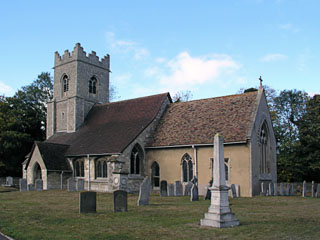Teversham looks quite interesting from outside - especially the tower, which is very nice. Square buttresses clasp the corners up to just below the bell-stage, which has stepped battlements of the form rather common in and around Cambridge.
The exterior of the nave and porch have been very aggressively restored, but the chancel is a pleasant historical jumble: as is common in those places where the rector was either too poor or too stingy to completely rebuild as fashions changed, they merely added new windows now and then, in a variety of different styles.
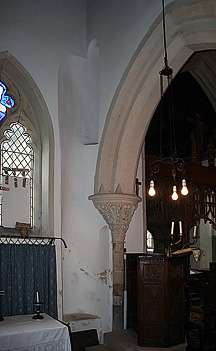 |
Inside, it’s clear that even in that restored nave there is quite a lot of early work, though much of it now indistinguishable from Victorian work. The interior is very plain. The tower sits somewhat inside the west end, so that the big square buttresses project into the nave. I liked the tower arch – it is large, with circular shafts running up to octagonal capitals from which the main arch springs. The nave itself is of three bays. The octagonal capitals on the arcades have been crisply recut, especially the easternmost pair, which are a most peculiar shape with very narrow bases and then sudden broad heads like big bunches of flowers.
Despite this, the structure is, in essence, very old - thirteenth century. This is made clear by the former clerestory windows, which now look through into the tops of the aisles (which are higher than their predecessors). The windows sit above the piers rather than the arches of the arcades, and are an odd squashed oval shape. There was no replacement clerestory inserted later, and the roof above is plain, though it looked like it was painted at one point.
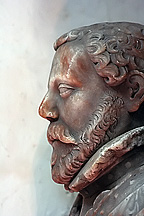 |
Not much else of interest survives in the nave, but there is a good alabaster monument at the west end of the south aisle. It commemorates Edward Styward, who died in 1596, and his wife Margery Kirby. The two figures lie side by side, missing their feet and hands, on a chest decorated with their shields.
On either side of the chancel arch are squints from the aisles looking at the high altar. The arch itself is filled with a shabby but very characterful rood screen. The northern half has a pair of panels at its base with original-looking blind arcading over the top; on the south, however, this has been replaced with plain round-headed Jacobean work. Above the screen is a beam, on which sits a crucifix liberally draped with cobwebs.
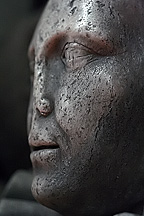 |
The chancel suffered dreadfully at the hands of William Dowsing. He visited here on 26 March 1643. Writing in his journal, he recorded:
'I broke a crucifix in the chancell, and there was Jesus written in great capital letters on six arches in the church, and in 12 places in the chancell, and steps there, the pavements digged up. The 6 Jesus in the church I did out, and six in the chancell, and the other six I could not reach, but gave orders to do them out. There was one side of the altar written Phil. ii.10. and on the other side, Psalm xcv . Come, let us worship and kneele , etc. and four suns painted; within the first writt, God the Father; and in the second, the Son; and in third, the Holy Ghost; and in the 4th, Three Persons and one God'.
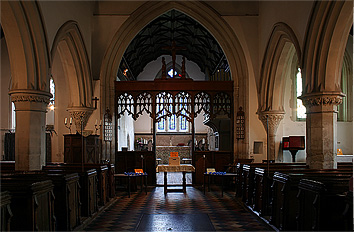 |
For this, and later reasons, much of what now sits in the chancel is Victorian. Some of it is good – I quite liked the stone panelling and reredos behind the high altar, for example – and some of it is bad – the roof is overpowering in such a small space. There are also a few pre-Dowsing survivals. On the south wall is a dilapidated piscina and a set of sedilia with three seats of varying height under shallow but cleanly cut ogeed canopies which reach up into the window.
Pausing before we left, I had a look through the history of the church. As often happened with livings close to the University, Teversham provided a posting for ambitious young churchmen on the make. Three rectors stick out particular, all of them staunch defenders of the High Church against Puritanism. One was was John Whitgift, between 1560 and 1572, during part of which time he was Regius Professor of Divinity and Master successively of Pembroke and Trinity Colleges.
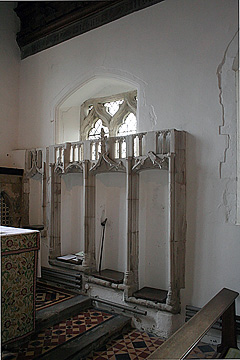 |
Whitgift rose to become Archbishop of Canterbury from 1583 till his death in 1604, and was famously described by the historian Macaulay as a ‘narrow, mean, tyrannical priest, who gained power by servility and adulation’. Whitgift’s successor as Archbishop, Richard Bancroft (who was the principal overseer of the Authorised Version of the Bible) was also Rector of Teversham, from 1576 to 1586. [Mark adds: That explains why there was so much finery for Dowsing to hack up. One wonders what happened to the man who covered the 4 years between these two eminent successes. Did he die? Or did he spend his later years propping up college bars telling anyone who would listen how he ‘could have been a contender’?...]
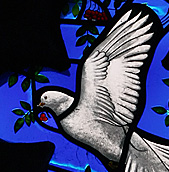 |
Then, in the seventeenth century, Matthew Wren was rector from 1615 till 1635. Wren was President of Pembroke College, then Master of Peterhouse while he held the Teversham living, before going on to be Bishop successively of Hereford, Norwich and Ely. His support for Archbishop Laud and High Church views meant that he was imprisoned by Cromwell from 1641 till 1659. Unlike his mentor Laud, he survived, and on his release he donated money to Pembroke College for the building of a new chapel, which was one of the first buildings to be designed by his nephew Christopher Wren.
A little less grand in its contents, but no less interesting to my mind, was the visitor’s book, which is the oldest we have found in Cambridgeshire, dating all the way back to 1933. This makes it two years older than nearby Horningsea, though without the same intriguing theological disputes raging back and forth in its pages.
All Saints is kept locked, and the keyholder is only
available
during office hours from Monday to Friday.
